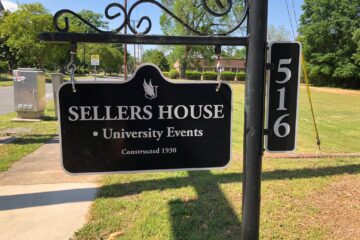An Insect Museum in the biology department is managed by Dr. Paula Mitchell. The professor has been managing the existing insect collection at Winthrop since 1995.
“When I arrived, I inherited a small insect collection (3 cabinets) from my predecessor, Dr. Luckett Davis, who had started the collection in the 1970s,” the Museum Collections Manager Dr. Paula Mitchell said.
While her teaching at Winthrop began with instruction in Entomology, she is now retired and continues to manage the collection in a part time position as the Museum Collections Manager.
“If no one cares for a collection it ends up being destroyed by dermestid beetles,” Mitchell said. “Dermestid beetles are the curse of an insect collection. The larvae burrow into the dried pinned specimens and eat them from the inside out, leaving piles of dermestid poop that look like dust piles. Once you see one of those piles, the specimen is usually damaged beyond repair.”
Mitchell has added to the collection over the years by doing her own field work and by having students from classes such as BIOL 520: Entomology and BIOL 304: Insect Field Studies turn in insects as part of the class.
There are two methods in which people can catch and donate insects to the department.
“Small insects can go directly into a small container of over the counter rubbing alcohol. This kills them and preserves them” Mitchell said. “Larger insects can be put in a plastic container or Ziploc back and put in the freezer for 48 hours, then brought to me within 25 hours of defrosting.”
In addition to bringing in a specimen for donation, Mitchell will need information such as the date of the collection, geographic location including state, county and town and the collectors full name.
One of the most valuable specimens in the collection is the African Goliath beetle.
“This species is one of the most massive beetles in the world,” Mitchell said.
One of the best backstories of a specimen is connected to a mole cricket that was donated by two young brothers. The two brothers found the cricket near the Catawba Nuclear Station.
“Mole crickets are so weird looking that they were absolutely convinced it was a mutant cricket caused by exposure to radiation,” Mitchell said. “I hated to disappoint them, but they were somewhat consoled by the fact that the specimen would permanently bear their names as collectors.”
One area of the collection that Mitchell would like to expand is the collection of Lace bugs.
“I am presently co-authoring a book on the lace bugs of South Carolina,” Mitchell said. “Lace bugs are poorly represented in the Winthrop collection because they are tiny, 2-5 mm in length, and most students prefer to collect large insects.”
In addition to the insect collection, the museum also contains plants, vertebrates, and shells. Dr. Kunsiri Grubbs is in charge of managing the plants and Dr. William Rogers, an emeritus professor manages the vertebrates.
Currently no one is looking over the shell collection since dermestid beetles do not eat shells.
“There is something nice about knowing that an insect you’ve collected will be preserved in perpetuity with your name on it,” Mitchell said. “I think of it as a tiny bit of immortality.”
If students are interested in an individual tour or would like to donate to the collection email Dr. Paula Mitchell at mitchellp@winthrop.edu.




